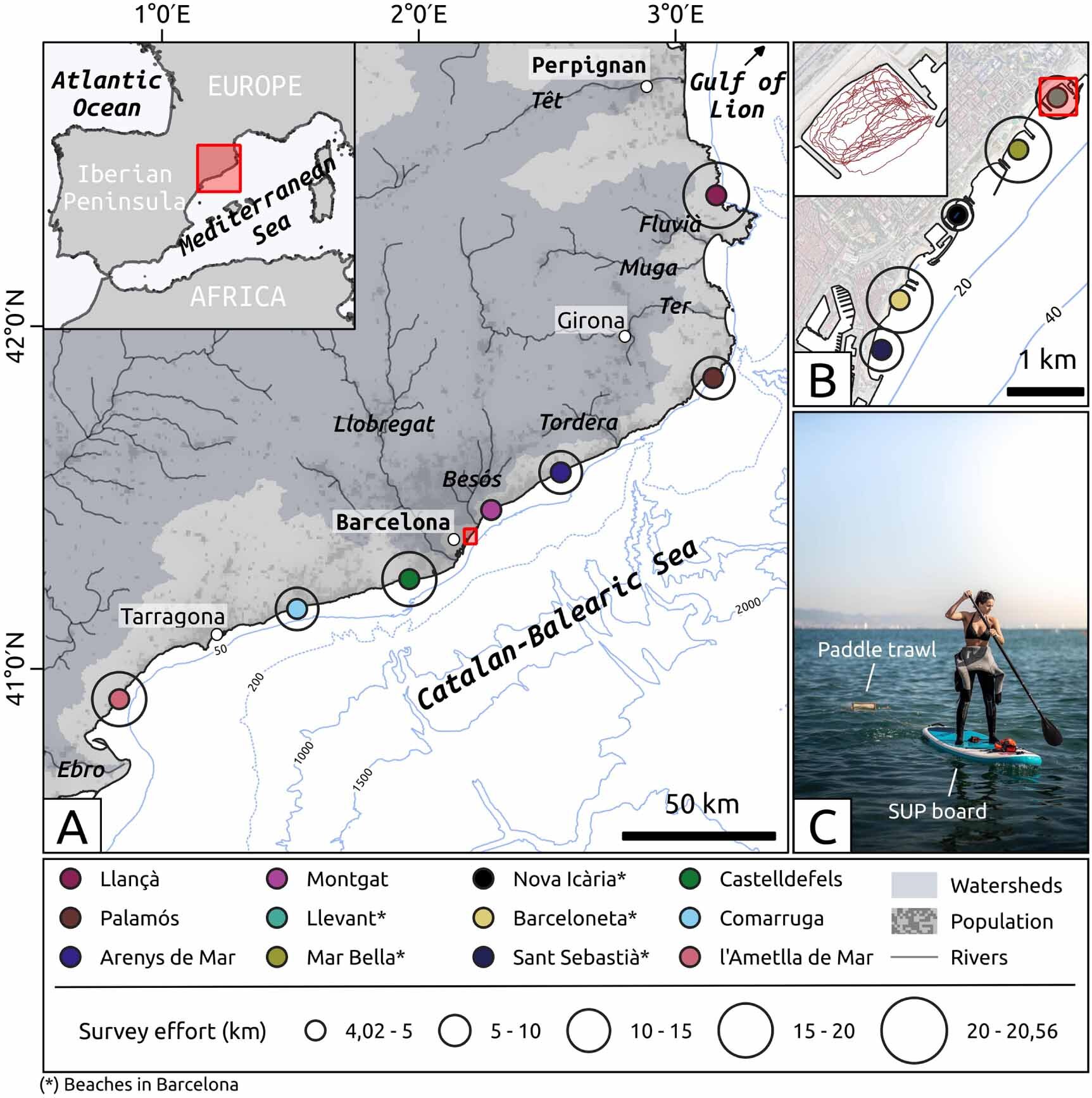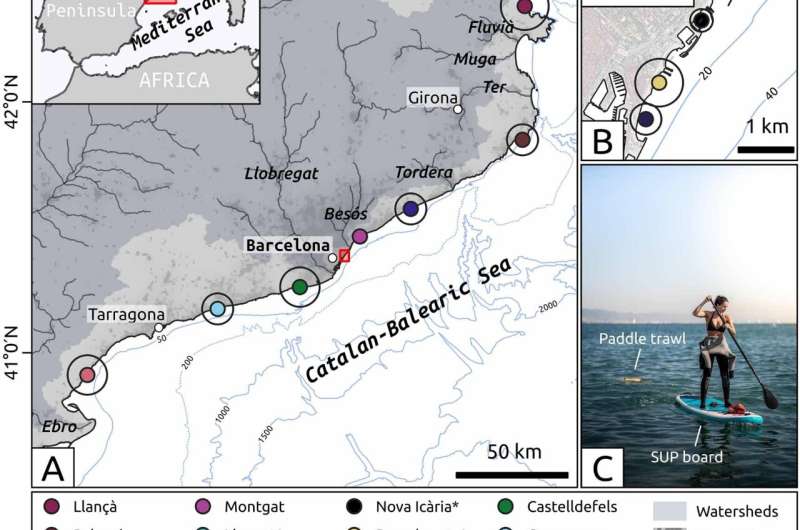

The presence of microplastics in the oceans is widely documented/reported by oceanographic research, but data on the pollution in the nearshore regions are scarce due to access difficulties faced by scientific boats. Researchers from the Consolidated Research Group on Marine Geosciences of the Faculty of Earth Sciences of the UB, in collaboration with the Spanish delegation of the NGO Surfrider Foundation Europe, studied the quantity and features of floating plastics in the Catalan coasts, thanks to a citizen science initiative in which volunteers collected 25,000 microplastics with special nets towed from rowing boats. The results, published in the open-access journal Environmental Research Letters, reveal that coastal areas feature a vast amount of plastic debris, the presence of which is under a great spatial and temporal variability.
“The average concentrations of microplastics we found near the shore are above those previously found outside the bathing areas. We have detected higher maximum concentrations—more than six plastics per square meter—and more frequent over time. Also, there are some areas and times of the year in which these exceed by an order of magnitude the averages found in the open Mediterranean Sea and worldwide,” notes UB lecturer and researcher Anna Sanchez-Vidal.
“Citizen science is a useful and powerful tool for studying marine pollution, while it empowers citizens with scientific knowledge,” says Sanchez-Vidal.
More plastics in highly populated urban areas
These high amounts of microplastics indicate, according to the authors, that “there must be processes that tend to concentrate or retain plastics in the nearshore.” The study presents some explanations, such as variations in meteorological and oceanographic conditions, the higher influence of river flows during periods of heavy rains, and the proximity to highly populated urban areas with a great seasonal tourist influx, and the concentrating effect of areas limited by breakwaters or harbors.
“Beaches such as Mar Bella or Sant Sebastià, in Barcelona, are more protected from the wind and the waves due to these structures and could retain and accumulate more microplastics than other areas that are more exposed, which indicates a longer residence time,” says William P. de Haan, UB researcher and first author of the article. In this sense, the areas where the researchers detected more microplastics were the beaches of Sant Sebastià, Nova Icària and Llevant, all three in the Catalan capital. Furthermore, the researchers identified a potential seasonality. “We noticed that areas such as Llançà or Castelldefels show a lower tendency in January and February, probably due to the influence of surface currents and winds that reduce floating microplastics, and a higher tendency just before and after the summer months,” notes the researcher.
Finding the origins of microplastics to create better solutions
The study did not only determine the abundance of microplastics but it also provided a detailed characterization of size, color, shape and composition that can help determine the sources of the microplastics, which is essential to provide solutions to the growing presence of plastics in the marine environment. The results showed that foams and filaments, coming from food packaging and fishing activity accounted for nearly 11% of the collected plastics. However, most of the plastics were identified as fragments, films and sheets, which probably originated from the breakdown of larger plastic pieces. “We could identify polyethene films and sheets, originating from the fragmentation of bags; fragments of polyethene and polypropylene, from the fragmentation of bottles or packages; fragments of expanded polystyrene, used in food packaging; filaments from fishing gears, fragments of artificial grass, etc.,” says Anna Sanchez-Vidal.
This information, ranging from the physical features of microplastics to the concentrations of each in the sample areas, is available on a website with several visualization tools to make these findings access-friendly for society.
From Llançà to l’Ametlla de Mar
In the study, the researchers used samples that volunteers from eight Catalan entities had collected for seven months. From Llançà to l’Ametlla de Mar, these volunteers were coordinated by the entity Surfrider Foundation Europe. “There was a lot of participation, and this proves that citizen science is a tool with a great potential to monitor and study the impact of plastics on the marine environment,” says Maria Ballesteros, head of volunteering in Surfrider Spain.
These volunteers went to the beach every week or every two weeks for an hour with surfboards, kayaks and other rowing boats. They attached a net designed by the researchers to collect the floating microplastics of more than 0.3 millimeters. The path and coordinates of these transects were recorded on a mobile device and on the Wikiloc app in order to register the latitude, time and distance of the trawling. Then, the collected plastics were sent to the laboratory at the University of Barcelona to be analyzed by trained personnel. “We were surprised by the amount of high quality and scientifically relevant data we obtained in such a short time and lower budget compared to other similar scientific projects,” stresses Anna Sanchez-Vidal.
“The projects that involve research centers and society are key for continuing with the search for solutions to the problems of plastics in the oceans,” notes Maria Ballesteros.
Research in the Catalan and Basque coasts
The next step of this project is to analyze whether the detected tendencies in this study are maintained over time, the specific factors that lead to the detected variations and the evolution in the microplastics concentration in the short and long term.
With these objectives, the citizen science project will continue during the upcoming months. Also, it will expand the sampling areas to the Basque coast. “This will enable us to better understand the dispersal mechanisms and the characteristics of microplastics in a semi-closed sea in the western Mediterranean and in a relatively low populated area, but with a great fishing activity in the Atlantic Ocean,” concludes Anna Sanchez-Vidal.
Citizen science and paddle surfing to study microplastic pollution on Barcelona’s coastline
William P de Haan et al, Floating microplastic loads in the nearshore revealed through citizen science, Environmental Research Letters (2022). DOI: 10.1088/1748-9326/ac5df1
University of Barcelona
Citation:
Citizen science study detects vast amount of microplastics in Catalan bathing areas (2022, May 9)
retrieved 9 May 2022
from https://phys.org/news/2022-05-citizen-science-vast-amount-microplastics.html
This document is subject to copyright. Apart from any fair dealing for the purpose of private study or research, no
part may be reproduced without the written permission. The content is provided for information purposes only.